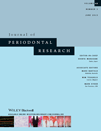Porphyromonas gingivalis displays a competitive advantage over Aggregatibacter actinomycetemcomitans in co-cultured biofilm
Abstract
Background and Objective
Biofilm formation occurs through the events of cooperative growth and competitive survival among multiple species. Porphyromonas gingivalis and Aggregatibacter actinomycetemcomitans are important periodontal pathogens. The aim of this study was to demonstrate competitive or cooperative interactions between these two species in co-cultured biofilm.
Material and Methods
P. gingivalis strains and gingipain mutants were cultured with or without A. actinomycetemcomitans. Biofilms formed on glass surfaces were analyzed by crystal violet staining and colony counting. Preformed A. actinomycetemcomitans biofilms were treated with P. gingivalis culture supernatants. Growth and proteolytic activities of gingipains were also determined.
Results
Monocultured P. gingivalis strains exhibited a range of biofilm-formation abilities and proteolytic activities. The ATCC33277 strain, noted for its high biofilm-formation ability and proteolytic activity, was found to be dominant in biofilm co-cultured with A. actinomycetemcomitans. In a time-resolved assay, A. actinomycetemcomitans was primarily the dominant colonizer on a glass surface and subsequently detached in the presence of increasing numbers of ATCC33277. Detachment of preformed A. actinomycetemcomitans biofilm was observed by incubation with culture supernatants from highly proteolytic strains.
Conclusion
These results suggest that P. gingivalis possesses a competitive advantage over A. actinomycetemcomitans. As the required biofilm-formation abilities and proteolytic activities vary among P. gingivalis strains, the diversity of the competitive advantage is likely to affect disease recurrence during periodontal maintenance.




